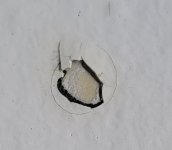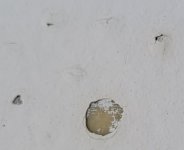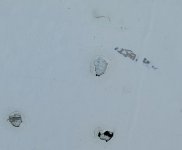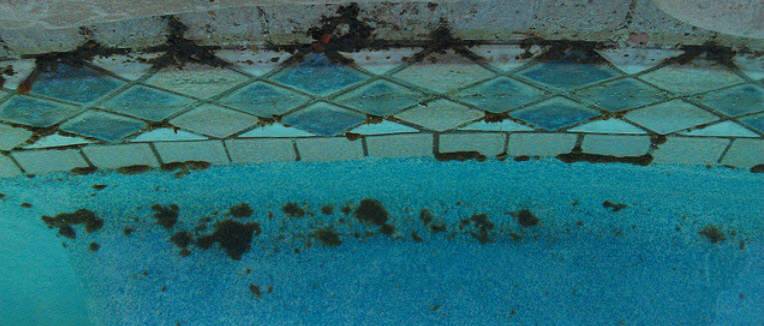So I'm battling some black algae which is mostly not visible from the surface but I'm a scuba diver and can see many small dots of it plainly when I go in with a mask & fins. I rent the house and the property manager told me when I moved in 2 1/2 years ago that the pool has some sort of smooth coating which allows algae growth to be easily scrubbed off with a brush.
I got into this mess as I didn't know the relationship between trichlor pucks, CYA and FC. The property manager obviously doesn't know squat about pools as he told me to just use the pucks. So I almost completely drained the pool (he didn't want to completely drain it for fear of it popping) and scrubbed the shallow end with a strong solution of chlorine and algaecide. Obviously it couldn't kill everything in the pool completely (I don't even think it killed the stuff in the shallow end) and now a couple of weeks after draining it's still there.
My neighbor, who has a pool and also just recently learned about CYA and FC (from me) doesn't have a problem with high CYA as he has a SWG. He's a knowledgeable retired construction guy but he tells me I can't use a wire brush on the pool since my pool is the same construction as his. He's not THAT knowledgeable though as he said they were fiberglass which I can't believe. The surface of his pool seems somewhat smoother than mine but nothing as smooth as what I believe would be fiberglass or a vinyl liner.
I scrubbed the black algae spots one time with a small hand wire brush with my scuba equipment and the surface didn't seem to get damaged in any way.
Attached are a couple of pics I took of a couple of cracks in the shallow end when it was drained. These cracks just appeared in the past couple of years. This can't possibly be a fiberglass or vinyl pool liner, can it? What else would it be? I put plaster in my signature when I joined as that's what I believed it to be at the time.
I am in the middle of a SLAM and believe if I can't use a wire brush there's no way I'm going to kill this stuff.
Side Note: the round cracks in the pictures are a bit smaller than a quarter. The black around the edges of the cracks I am sure is black algae.



I know that how much FC you lose during the day is dependent on both the UV and CC levels (as well as organic content in the pool) but just say you have low CC and organic content in the pool, do you lose significantly more FC when your FC levels are at SLAM level (e.g. mine are above 20 ppm) than when they are at "normal" levels?
As vague as your question is the general answer is ... No.
Well let’s get into specifics. You mention Fc of 20 which is CYA of 50. The answer is no.
When you get to SLAM levels for the higher CYA levels with FC of 30+ then you can see a few ppm of FC lost through the chlorine degradation. So the loss of a few ppm of FC if trying to do a Overnight Chlorine Loss Test may not be meaningful.
Well I didn't post any numbers. I've had a lot going on but one test from 6AM-1PM today I lost 8 PPM. Going to perform an OCLT test tonight to see what that reveals. The pool was recently drained 2 weeks ago with no swimming activity so there is little to no CC but I have a (currently minor) black algae issue so I want to see what that test reveals.
Any feedback on that appreciated Battling Black Algae - Can I use a wire brush or... (pics now attached)
Ok a few PPM overnight may not be meaningful but I lost 8 PPM during the first 7 hours of daylight. I know I need more data and will get more tonight and tomorrow.
I got into this mess as I didn't know the relationship between trichlor pucks, CYA and FC. The property manager obviously doesn't know squat about pools as he told me to just use the pucks. So I almost completely drained the pool (he didn't want to completely drain it for fear of it popping) and scrubbed the shallow end with a strong solution of chlorine and algaecide. Obviously it couldn't kill everything in the pool completely (I don't even think it killed the stuff in the shallow end) and now a couple of weeks after draining it's still there.
My neighbor, who has a pool and also just recently learned about CYA and FC (from me) doesn't have a problem with high CYA as he has a SWG. He's a knowledgeable retired construction guy but he tells me I can't use a wire brush on the pool since my pool is the same construction as his. He's not THAT knowledgeable though as he said they were fiberglass which I can't believe. The surface of his pool seems somewhat smoother than mine but nothing as smooth as what I believe would be fiberglass or a vinyl liner.
I scrubbed the black algae spots one time with a small hand wire brush with my scuba equipment and the surface didn't seem to get damaged in any way.
Attached are a couple of pics I took of a couple of cracks in the shallow end when it was drained. These cracks just appeared in the past couple of years. This can't possibly be a fiberglass or vinyl pool liner, can it? What else would it be? I put plaster in my signature when I joined as that's what I believed it to be at the time.
I am in the middle of a SLAM and believe if I can't use a wire brush there's no way I'm going to kill this stuff.
Side Note: the round cracks in the pictures are a bit smaller than a quarter. The black around the edges of the cracks I am sure is black algae.



I know that how much FC you lose during the day is dependent on both the UV and CC levels (as well as organic content in the pool) but just say you have low CC and organic content in the pool, do you lose significantly more FC when your FC levels are at SLAM level (e.g. mine are above 20 ppm) than when they are at "normal" levels?
As vague as your question is the general answer is ... No.
What was vague about the question? There’s more than one recent thread on this site indicating that really high chlorine (even at SLAM level) seem to burn off faster than lower levels.As vague as your question is the general answer is ... No.
Well let’s get into specifics. You mention Fc of 20 which is CYA of 50. The answer is no.
When you get to SLAM levels for the higher CYA levels with FC of 30+ then you can see a few ppm of FC lost through the chlorine degradation. So the loss of a few ppm of FC if trying to do a Overnight Chlorine Loss Test may not be meaningful.
Well I didn't post any numbers. I've had a lot going on but one test from 6AM-1PM today I lost 8 PPM. Going to perform an OCLT test tonight to see what that reveals. The pool was recently drained 2 weeks ago with no swimming activity so there is little to no CC but I have a (currently minor) black algae issue so I want to see what that test reveals.
Any feedback on that appreciated Battling Black Algae - Can I use a wire brush or... (pics now attached)
Well let’s get into specifics. You mention Fc of 20 which is CYA of 50. The answer is no.
When you get to SLAM levels for the higher CYA levels with FC of 30+ then you can see a few ppm of FC lost through the chlorine degradation. So the loss of a few ppm of FC if trying to do a Overnight Chlorine Loss Test may not be meaningful.
Ok a few PPM overnight may not be meaningful but I lost 8 PPM during the first 7 hours of daylight. I know I need more data and will get more tonight and tomorrow.
Last edited:


